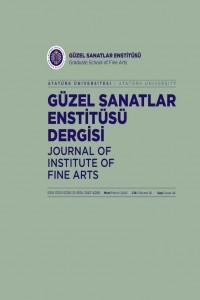SIRSIZ SERAMİKLERDEN BİR GRUP: SÜZGEÇLİ TESTİLER/SÜZGEÇLER
Sırsız seramik/toprak kaplar Neolitik dönemden itibaren insanoğlunun ihtiyaçları ve coğrafi koşullara bağlı olarak farklı yöntemlerle, farklı formlarda üretilmiştir. Bu çalışmada sırsız seramikler arasında yer alan ve Türk seramik sanatında pek bilinmeyen bir grup oluşturan süzgeçli testiler, testi süzgeçleri üzerinde çalışılmıştır. Hasankeyf kazılarında, özellikle Büyük Saray kazılarında çok sayıda süzgeç parçası ele geçmiştir. Fakat kazılarda sağlam/tüm süzgeçli testi az sayıda bulunmuştur. Bu tür kil süzgeçler Erken İslam döneminden itibaren İslam seramik sanatında görülmektedir. Testinin silindirik boynunun içine/farklı seviyelere yerleştirilen bu süzgeçler, testi boynunun genişliğine bağlı olarak farklı büyüklüklerdedir. Göze doğrudan görünmeyen dar /kapalı bir alana yerleştirilen bu küçük dairesel yüzeyler ajur tekniğinde çok özenli, birbirinden farklı bezemelerle süslenmiştir.
Anahtar Kelimeler:
Testi, Süzgeç, Sırsız Seramik, Hasankeyf
-
As from Neolithic period, unglazed ceramics and pots have been produced in different techniques and forms depending on geographical conditions and the needs and necessities of human beings. The aim of this study is to introduce filters that belong to a group of fairly unrecognized unglazed ceramics of Turkish ceramics. A large number of filter pieces have been captured in Hasankeyf excavations, especially among the ones in Büyük Saray. However, undamaged filters are few. This sort of clay type filters can be seen in Islamic ceramics as from early Islamic period. These filters are placed into cylindrical neck of jugs. They are in different sizes depending on width of the neck. These small surfaces are placed in a narrow and closed area that cannot be seen directly. Different decorations in openwork technique are done on these surfaces.
Keywords:
Jug, Filter, Unglazed Ceramic, Hasankeyf,
___
- Fehervari, G . (2000).Ceramics of the Islamic World in the Tareq Rajab Museum , New York.
- Grube, E.J. (1976). Islamic Pottery of The Eighth to the Fifteenth Century in the Keir Collection, London.
- Özkul Fındık, N. (2009). Hasankeyf Seramikleri (2004-2006), Ankara. Riis, P.J.-V. Poulsen, (1957). Hama, Fauilles et Recherches 1931-1938, Vol IV, pt.2, Copenhagen.
- Watson, O. (2004). Ceramics From Islamic Lands; Kuwait National Museum, The Al-Sabah Collection, London.
- Wilkinson, C.K. (1973). Nişapur:Pottery Of The Early Islamic Period, New York.
- ISSN: 1300-9206
- Yayın Aralığı: Aylık
- Yayıncı: Atatürk Üniversitesi
Sayıdaki Diğer Makaleler
İTALYA ÖRNEKLERİYLE DAİRE BİÇİMLİ KAPI TOKMAKLARI
BİR SELÇUKLU ÇİNİ TEKNİĞİ; SIR KAZIMA
İSHAK PAŞA SARAYI TAÇKAPILARININ BEZEMELERİ AÇISINDAN DEĞERLENDİRİLMESİ
SIRSIZ SERAMİKLERDEN BİR GRUP: SÜZGEÇLİ TESTİLER/SÜZGEÇLER
VAN GÖLÜ HAVZASI’NDA BAT VE KERPİÇİN MİMARİDE KULLANIMI
ÇUKUROVA TOROS DAĞLARINDA BİR ORTAÇAĞ YAPISI: MARAN KALESİ
